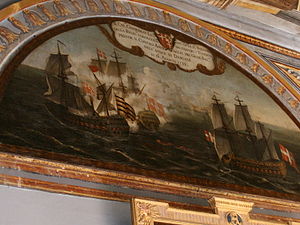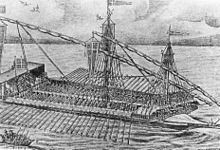Sea battle at Damiette

Fresco from the naval battle in the Grand Master’s Palace on Malta:
Left the dismantled Ottoman Sultana , in the middle Saint-Antoine and right the Saint-Georges of the Order.
| date | September 18, 1732 to September 19, 1732 |
|---|---|
| place | off Damiette ( Egypt ), Mediterranean |
| output | Victory of the Order of Malta |
| Parties to the conflict | |
|---|---|
| Commander | |
| Troop strength | |
| 2 ships of the line 2 tartans |
1 ship of the line ( flagship ) 40 merchant ships |
| losses | |
|
8 dead |
unknown number dead |
On August 16, 1732, a sea battle occurred in the Mediterranean near Damiette ( Egypt ) between the ships of a convoy of the Ottoman Empire and a small fleet of the Order of Malta under Jacques François de Chambray as the commander , who was responsible for the successful outcome of the battle and the liberation of Christian slaves was promoted to Grand Cross Knight of the Order of Malta.
prehistory

After the Knights of the Order of St. John settled on the islands of Rhodes and later Malta , sea operations based there offered themselves.
In the 16th century, the order built a small, effective fleet of war galleys , with which it successfully plundered shipping in the Muslim countries on the Mediterranean. The order fleet thus contributed significantly to the financing of the expansion of the facilities on Malta and Rhodes.
In the course of time, the fleet of the order , which was named after the settlement of Malta's Order of Malta , was supplemented by some of the galleons emerging in Europe . These were armed with many cannons and were therefore able to hold their own against several galleys . Liners were added in the 18th century .
Course of the naval battle
In July 1732 Jacques François de Chambray received as Lieutenant General ("Lieutenant général des armes de la Religion en mer et commandant de l'escadre des Vaisseaux", in German: Lieutenant General of the Arms of Religion at Sea and Commander of the Ship Squadron) of the Order of Malta from Grand Master Antonio Manoel de Vilhena was commissioned to sail south-east in order to intercept and capture a convoy of the Ottoman Empire there , as the order had gained knowledge of the whereabouts of the ships and there was a prospect of rich booty for the order.
On August 16, 1732, De Chambray and his small unit came across the Turkish convoy anchored near Damiette , which consisted of 40 merchant ships and was escorted by an escort .
The escort ship was the Sultana , the 70- gun ship of the line , on which the Ottoman Vice Admiral Kali Michamet had set his flag .
De Chambray, who had two ships of the line each carrying 60 cannons and two tartans , attacked the Turkish Sultana with his flagship Saint-Antoine and the ship of the line Saint-Georges , while the two tartans attacked the anchored convoy.
The Sultana resolutely defended herself against the two ships of the order, but could not prevent her from being dismasted. Although she subsequently suffered considerable damage and de Chambray threatened her crew to sink her, there was no surrender by Kali Michamat, who was finally able to save himself into the falling night without having to give up his ship. It was not until the next morning at around 10 a.m. that the Ottoman admiral gave the order to remove the flag , after his situation had apparently become hopeless.
Although the Sultana was still seaworthy, it was set on fire by the victorious sailors of the Saint-Georges . It fell into the hands of de Chambray and thus the order no longer as a pinch , which angered them very much.
The crews of the two tartans discovered in the meantime that many of the merchant ships they had captured were not carrying any cargo, so that the booty was less than hoped. Nevertheless, some cannons, 126 quintals of black powder, several spare sails, two cables, 70 baskets of rice, biscuits and other useful materials were seized as booty.
In addition, 117 Turkish slaves were taken over and 14 Christians who had previously been captured by the Turks were freed. The slaves were then brought to Malta and, after a customary quarantine period, used on galleys of the Order or auctioned off at the slave markets in Valletta . The average price for a Turkish slave on the market in Valletta was between 200 and 500 écus .
A total of eight sailors died and twelve were injured on the Order's side in the battle - nothing is known about the Turkish losses.
For the successful mission, De Chambray was promoted to Grand Cross Knight of the Order of Malta by the Grand Master of the Order of Malta at the time.
Notes / sources
- ↑ Since attacks on merchant ships were common, it happened that some merchant ships were sometimes equipped with cannons or other armaments to prevent capture. It is not known whether this was the case in the battle described here.
- ↑ Wismayer, p. 38
- ↑ The knights were later called "Knights of Malta" after the settlement of Malta.
- ↑ The independent fleet lasted until June 12, 1798, when Napoleon captured the island and also took over the entire fleet without a fight, as the order was not allowed to fight against Christians.
- ↑ The United States Naval Institute (USNI) researched the name Sultana , in Moureau the ship is also called La Sultana , in Dreux Du Radier it is called La Sultane Réal de Constantinople , in Wismeyer, p. 247, also as Bellina (ital. the pretty one )
- ↑ to Pemsel
- ^ To Castillo San Antonio , also Wismayer
- ^ To Castillo San Giorgio , also Wismayer
- ↑ a b c after Moureau
- ↑ It is unclear whether these slaves already had slave status before the battle, or whether they were Turkish seamen and traders who were subsequently enslaved by the Maltese.
- ^ To Castillo, also to Moureau
- ^ After Dreux Du Radier, also after US Naval Institute
literature
- Jean Francois Dreux Du Radier: L'Europe illustrious, contenant l'histoire abrégée des souverains . Volume 4, Paris 1757.
- François Moureau: Captifs en Méditerranée (XVI – XVIIIe siècles): histoires, récits et legends . Presses de l'université Paris-Sorbonne, 2008.
- Dennis Castillo: The Maltese Cross: a strategic history of Malta . Library of Congress, USA, 2006, ISBN 0-313-32329-1 .
- United States Naval Institute: Admiral de Grasse and American Independence . The United States Naval Institute, Annapolis (Maryland), USA, 1945.
- Joseph M. Wismayer: The Fleet of the Orders of St. John 1580-1798 . Midsea Books, Valletta 1997, ISBN 99909-75-30-2 .
- Helmut Pemsel: Command of the Sea. A maritime world history from the beginning until today . Augsburg 1995.
